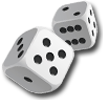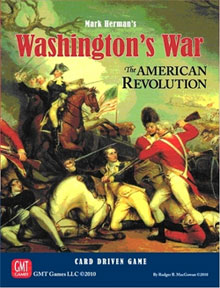



play board games
Board game reviews, strategy tips & session reports
Washington’s War Review
 Stats:
Stats:
No. of players: 2
Amount of time to play: 90-120 min
Age requirements: 12+
Set-up time: 15 minutes
Washington’s War Rules Description:
Washington’s War is a card driven war game. You play as the Americans or British and try to control enough colonies at the game’s end to win.
Each turn you get seven cards and alternate playing a card with you opponent. Cards may have events or one, two or three operation points (Ops). Event cards mimic historical events from the Revolution. Players take turns playing a card until the end of the war is reached.
Ops can be spent to place Political Control markers. Having the majority of Political Markers in a colony gives you control if it. You may also play an Ops card to bring Reinforcements onto the board. The Americans can reinforce twice per turn and the British may only reinforce once per turn.
The other main use for Ops is to activate a general. Activating a general allows him to move and attack. American generals require less Ops to activate. Once in a space with an opposing general you may attack that army. American generals can intercept a British general and cause them to fight and stop moving.
A battle begins by determining your general’s battle rating. One a roll of 1-3 their battle rating is halved and on a 4-6 it is not. The general’s battle rating can never be greater than the number of Combat Units (CUs) they have with them. After determining your general’s battle rating you add the number of your CUs and any advantages you have. British get a plus one for having better trained men. They also gain a plus one if they are fighting in a port. Either side may get a plus one for controlling the colony that the battle takes place in. And each player has an opportunity to discard a card for another plus one (plus two if it is a battle card). Next each player rolls a d6 and if the player with the highest total wins the fight. Ties go to the attacker. Battles result in losses so each side rolls on a chart to see if they have lost any units.
After both sides have played all their cards you check for Winter Attrition. CUs may be lost depending on where they are on the board and if they are with a general. The Americans suffer losses no matter where they are unless they are with General Washington.
Next you check for Isolation. Any American Political Control markers that cannot trace a path to a friendly general or CU, the Continental Congress or an unoccupied space is removed from the board. British Political Control markers are removed if they cannot trace a path to a friendly general or CU, a British controlled port or an unoccupied space.
Some events give the year in which the war will end, once that turn is over the game ends. The British win if they control six or more colonies. The Americans win if they control seven or more colonies. If both players meet their victory condition or neither player does, the British win.
Quick Review of Washington’s War:
Washington’s War is another fun card driven war game by GMT. It plays a bit quicker than some of their others but shares some similar mechanics.
I like the back and forth play of Washington’s War and the fact it can be played in 90 minutes or so. Your strategy will vary depending on which side you play. The British are a bit more straightforward game, but each side is fun to play.
You need to pay attention to where you place Political Control markers. If you don’t you could find yourself removing them because of Isolation. You need to balance military operations with colony control.
The components are well made and the art is good too. The rules are a bit confusing though. They aren’t poorly written but they are hard to follow. The description above is merely an overview and there are more rules and intricacies I didn’t mention. For some reason the rules just seem thick. After a couple plays things flow pretty well, but since both sides play so differently there are a bunch of exceptions. The player aids could give more information. And they would be even better if they were side-specific (one for Americans and one for British).
The mechanics and game play of this game are solid but there are a couple things I wish were different. First when you roll for your general’s actual battle rating there is a 50% chance he’ll be half effective. There is little rhyme or reason for this and it seems better to reduce this to a roll of one or two.
Also it is hard to eliminate armies. More often you are just pushing armies around. You could even win the combat and lose more CUs than your opponent. Winter Attrition can have a bigger effect on losing units than fighting (especially for the Americans).
I wish there were more events too. The events in Washington’s War are too similar to playing a card for Ops. They can help if the Continental Congress is dispersed, but I like the variety of events in GMT’s other card driven games better.
While Washington’s War is not flawless, it is far from a bad game. It has solid mechanics, fun game play and good strategic depth. It will take a couple plays to grasp the flow of the game but you’ll be rewarded if you stick with it. Being able to play both sides gives it extra replay value and variety. If you like games about the Revolutionary War you should try Washington’s War. If you like card driven war games and want one that has a shorter play time, try this.
Score and synopsis: (Click here for an explanation of these review categories.)
Strategy 4 out of 6
Luck 4 out of 6
Player Interaction 5 out of 6
Replay Value 4 out of 6
Complexity 5 out of 6
Fun 4 out of 6
Overall 4 out of 6

Clear and succinct review, thank you.